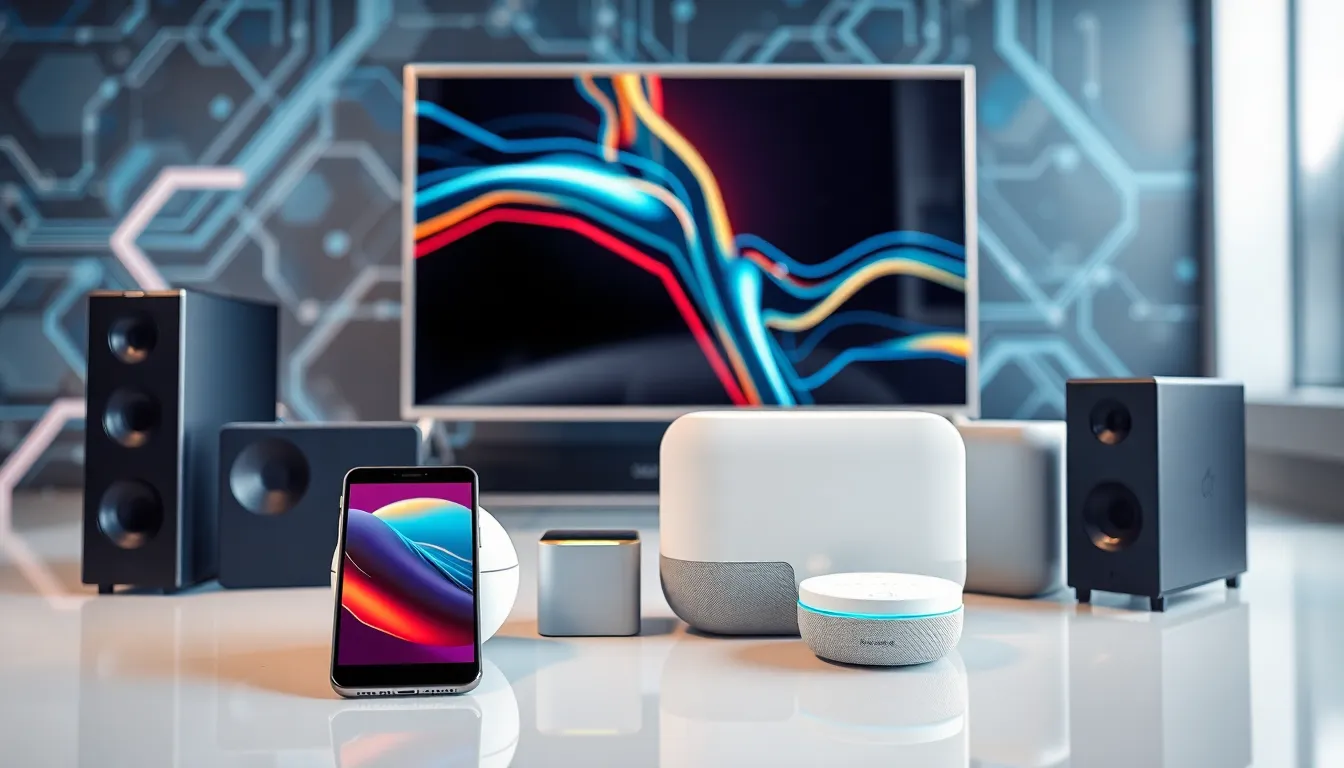In a world where gadgets seem to multiply faster than rabbits, consumer electronics companies are the wizards behind the curtain. They conjure up everything from sleek smartphones to smart fridges that can tell you when you’re out of milk—because who needs to remember that? As technology evolves at lightning speed, these companies are not just keeping up; they’re setting the pace for innovation and convenience in our daily lives.
Whether it’s the latest gaming console that promises to transport players to new realms or the headphones that make even the most mundane tasks feel like a concert, these companies are on a mission. They aim to make life easier, more enjoyable, and just a tad more exciting. So buckle up as we dive into the electrifying world of consumer electronics, where the only limit is your imagination (and maybe your wallet).
Table of Contents
ToggleOverview of Consumer Electronics Companies
Consumer electronics companies play a vital role in technological advancements. Major players like Apple, Samsung, and Sony lead the market, consistently introducing innovative devices. These companies design and manufacture a wide range of products, including smartphones, tablets, and smart home devices.
Apple focuses on user-centric design, creating products with seamless integration across devices. Samsung invests heavily in research and development, pushing the boundaries of display technology. Sony combines entertainment and technology, offering gaming consoles and high-quality audio equipment.
Many other companies contribute to the market. LG and Panasonic specialize in home appliances, enhancing everyday convenience with smart technology. Smaller firms often introduce niche products, catering to specific consumer needs. They drive innovation by addressing emerging trends, such as sustainability and connectivity.
Market dynamics reflect shifting consumer preferences. Increased demand for smart home devices has led to rapid growth in the sector. Additionally, wearables, such as smartwatches and fitness trackers, have gained traction, impacting consumers’ daily habits.
Data supports these trends. According to Statista, global consumer electronics revenue reached approximately $1 trillion in 2021 and is projected to grow annually. Research indicates that smart home device sales could surpass 500 million units by 2025.
Regulatory issues and supply chain challenges impact production. Companies often adjust strategies to meet changing market conditions. Adapting to technological advancements remains crucial for staying competitive while addressing consumer expectations effectively.
Key Players in the Market

The consumer electronics market features a diverse range of companies, each contributing uniquely to technological advancements. Established brands dominate the landscape while emerging companies carve out innovative spaces.
Established Brands
Apple, Samsung, and Sony lead the consumer electronics sector, recognized for their technological prowess. Apple’s iPhone and ecosystem of devices enhance user experiences through seamless interfaces. Samsung excels in display technology, producing cutting-edge televisions and smartphones. Sony remains a key player, combining gaming consoles with high-quality audio systems. LG and Panasonic also make significant contributions, focusing on home entertainment and appliances. These companies account for a substantial portion of the industry’s revenue, showcasing their impact on consumer preferences and market trends.
Emerging Companies
Emerging companies inject fresh ideas and agility into the consumer electronics market. Startups often focus on niche areas like sustainability, smart home devices, and personal electronics. Brands like Wyze innovate with budget-friendly smart home solutions, appealing to cost-conscious consumers. Others, such as Anker, specialize in portable power and charging technology, expanding access to essential electronics. These newer entrants create opportunities within the industry, responding quickly to shifting consumer demands and preferences.
Trends in Consumer Electronics
Consumer electronics continues to evolve rapidly, driven by innovation and market demands. Companies respond to these trends, focusing on technology and sustainability.
Technological Innovations
Consumer electronics companies prioritize robust technological innovations. New features enhance user experiences, making devices more intuitive and interconnected. For instance, advancements in artificial intelligence (AI) enable smarter interactions through voice commands and automation.
Wearable technology flourishes, offering health tracking and customization. According to Statista, approximately 154 million wearable devices shipped globally in 2021, reflecting strong consumer interest. Innovations in smart home integration create ecosystems where gadgets communicate seamlessly. Electroluminescent displays and foldable screens on smartphones demonstrate substantial design shifts, showcasing creativity.
Sustainability Efforts
Sustainability is increasingly important in consumer electronics. Companies implement eco-friendly materials in their products to reduce environmental impact. Notably, Apple commits to using recycled aluminum in devices, aiming for a closed-loop supply chain.
Brands like LG focus on energy-efficient appliances, promoting lower electricity consumption. Firms are also adopting sustainable packaging, minimizing waste during shipping. Additionally, many companies now emphasize longevity and reparability of products, which aligns with growing consumer preference for sustainable practices. According to a 2022 survey, 70% of consumers prefer brands that prioritize sustainability in their operations.
Market Challenges
Consumer electronics companies face several significant challenges in today’s dynamic market. Competition and pricing dynamics shift frequently, placing pressure on brand strategies and profitability.
Competition and Pricing
Competition intensifies with new entrants and established giants constantly innovating. Price wars emerge as companies strive for consumer attention, leading to reduced profit margins. Market leaders like Apple and Samsung maintain premium pricing by investing heavily in research and development. Smaller firms, including startups like Wyze, leverage low-cost alternatives to attract budget-conscious buyers. Pricing strategies often hinge on product features and consumer perception, with brands needing to balance quality and affordability. According to recent surveys, nearly 60% of consumers prioritize price when selecting electronics, underscoring the need for companies to refine their offerings to remain appealing.
Supply Chain Issues
Supply chain challenges remain a critical concern for consumer electronics. Disruptions, such as those caused by the pandemic, highlight vulnerabilities in the logistics of component sourcing. Shortages in semiconductors have led to production delays, affecting product availability. Companies often invest in diversifying suppliers to mitigate risks and enhance resilience. Responsiveness in the supply chain can significantly impact sales, as consumers expect timely delivery of the latest gadgets. A 2023 report indicates that 75% of businesses face supply chain disruptions, emphasizing the need for continued adaptation and strategy refinement in the industry.
Future Outlook for Consumer Electronics Companies
Companies in the consumer electronics sector will continue innovating as they navigate evolving market demands. Growth in smart home devices and wearables indicates shifting consumer preferences, with data showing 154 million wearables shipped globally in 2021. Sustainability emerges as a significant priority for many brands, with 70% of consumers favoring companies that prioritize eco-friendly practices.
Competition among industry leaders remains fierce. Apple and Samsung invest heavily in research and development, maintaining premium pricing while driving innovation. In contrast, budget-friendly companies like Wyze find success by offering cost-effective solutions that appeal to price-sensitive consumers.
Supply chain resilience ranks high on the agenda for consumer electronics companies. With 75% of businesses experiencing supply chain disruptions, firms are diversifying their suppliers to enhance their operational stability. Semiconductor shortages and production delays prompt these companies to adapt strategies that align with consumer expectations for timely delivery.
Technological advancements continue shaping the landscape. Artificial intelligence offers opportunities for smarter interactions, increasing user engagement across devices. Expectations for advanced features in smartphones and appliances rise, pushing companies to innovate continuously.
Consumer electronics brands that recognize the value of agility will thrive. Emerging companies inject fresh ideas into the market, catering to niche demands while established players maintain their leading positions. The future of consumer electronics reflects a blend of cutting-edge technology, sustainability, and a keen understanding of consumer desires, ensuring dynamic growth in the years ahead.
The landscape of consumer electronics is poised for remarkable growth and transformation. As companies push the boundaries of innovation they’re not just enhancing user experiences but also addressing critical issues like sustainability. The competitive spirit among established giants and emerging startups alike fosters an environment ripe for creativity and adaptability.
With advancements in artificial intelligence and a focus on eco-friendly practices the future looks bright. Consumers can expect a diverse range of products that cater to their evolving needs. As this dynamic industry continues to adapt to challenges and opportunities it promises to redefine how technology integrates into daily life.




